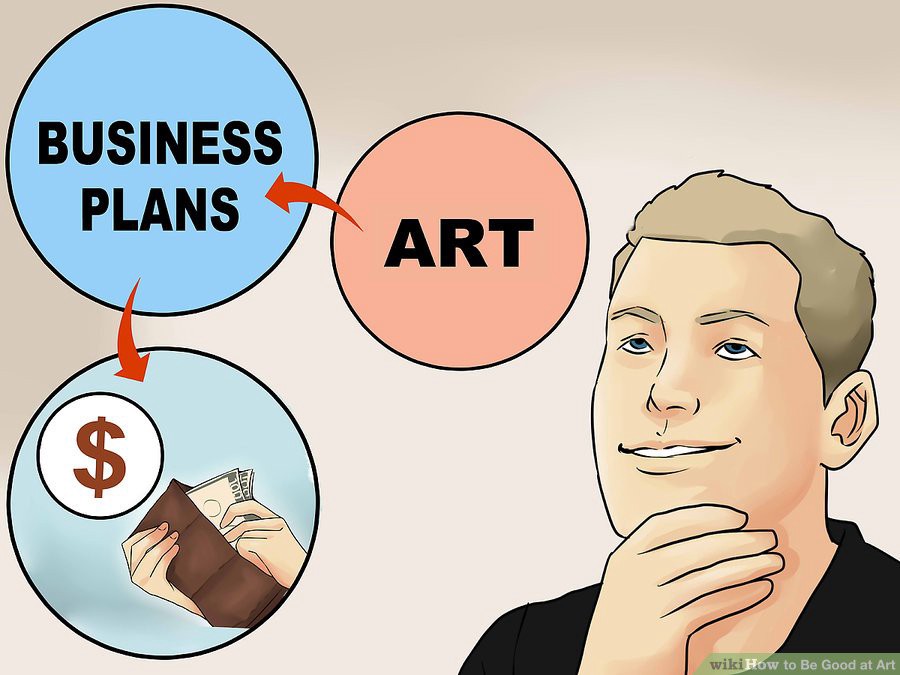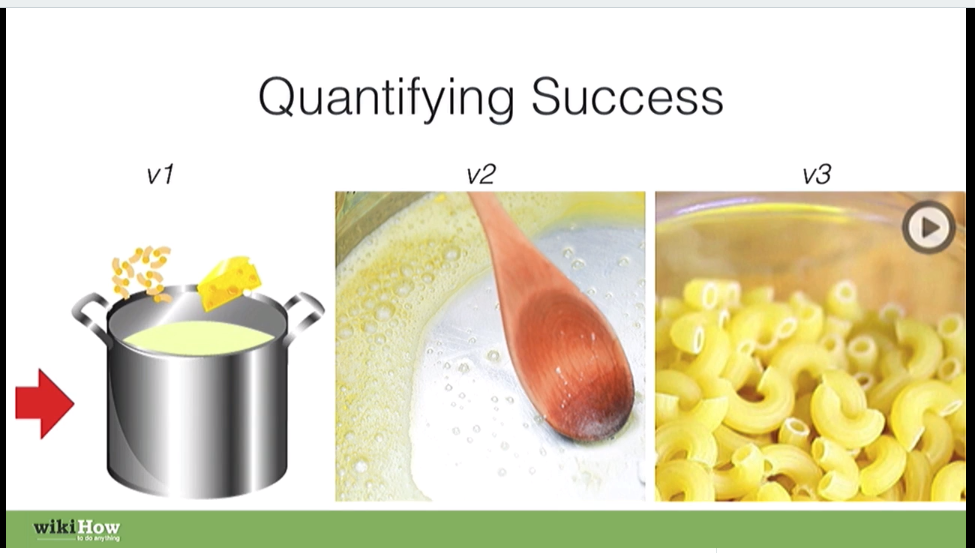Getting to the bottom of one of the internet?s most ridiculously drawn mysteries
 Image: wikiHow
Image: wikiHow
 Image: LDV Vision Summit
Image: LDV Vision Summit
?Here?s the thing though, it still led to an increase to traffic on the page,? Scher said, referring to the clip-art style graphic. ?We were being rewarded for adding images, regardless of whether or not the images were crappy.?
Scher notes during his talk that, in certain cases, wikiHow opted to commission original photography or create videos as opposed to drawings, as these often tested better for metrics like engagement, ?helpfulness,? and ?authority.? Regardless, the company leaned into making illustrations en masse in 2011.
?It was so worth the cost, we did it at scale. Over four years we ended up doing 1.4 million custom visuals, and those are live on over 150,000 of our articles. That?s a lot, and it?s taken a lot of manpower to make it happen, and we?re constantly trying to move the needle even further on that visual content.?
?This project kind of started as, frankly, something completely experimental in 2011,? Hadley told me. ?We just wanted to see if we could find people to help us create custom images for our articles.?
Hadley said the secrecy around wikiHow art exists partly because the system worked so well. ?It was new, but we felt like we had something that was really special, so we kind of asked people to keep it a bit of a mystery,? he said. ?And, over the years, kind of maintaining the enigma has been part of the fun? that mystery has been a part of why this stuff has gained traction.?
Still, traces of the operation can be found online. Dozens of professional profiles on sites like LinkedIn and Behance mention freelance illustration for wikiHow. The vast majority list locations in the Philippines, with others based in countries including Argentina, Romania, Bulgaria, Macedonia, Turkey, India, Indonesia, and New Zealand. A search of the Philippines-specific job portal onlinejobs.ph with a ?Pro? account turned up a dozen more profiles who listed past freelance illustration experience at the site.
Two Philippines-based illustrators attached specific examples of art they created for wikiHow guides to their profiles or websites. Their work is currently featured on multiple live wikiHow articles. One of the artists noted that she?d ?illustrated 3000+ articles? over a span of more than four years. Eight artists based in the Philippines, and one in the U.S., confirmed to OneZero that they?d created art on a freelance basis at some point for wikiHow.
LinkedIn profiles of wikiHow?s in-house team also indicate a worldwide illustration operation. Daisy Chung, wikiHow?s current creative director, lists one of her responsibilities as ?provid[ing] creative direction to a large global team of illustrators.? Brooke Matthews, who, according to her LinkedIn, worked at wikiHow from 2012 to 2017, first as a ?Project Manager of Visual Content? and eventually ?Director of Visual Content,? notes that she ?led the creation of over 2.5+ million custom digital media assets,? ?traveled globally to meet with content producers and hold artist workshops,? as well as ?mentored two in-house visual team project managers.?
?The artists on wikiHow really are people all over the globe,? said Hadley. ?Probably the only place you won?t find some sort of wikiHow artist is in Antarctica.?
Contracts with nondisclosure agreements could potentially be to blame for how few artists mention working for wikiHow publicly relative to the site?s humongous volume of illustration work. For instance, one self-employed illustrator listed their work experience as ?2 years as illustrator in WikiHow? on one online professional profile, but, on another, only said they?d been ?hired in NDA contract with certain company as illustrator? for two years and 10 months. When contacted by OneZero, this artist confirmed she?d signed an ?NDA form (non disclosure agreement),? and asked which website listed the information so she could take it down.
The eight Philippines-based artists OneZero interviewed said they found out about the wikiHow opportunity in a variety of ways. One former freelancer told me she?d started drawing for wikiHow after a ?guy randomly went to my university and start[ed] asking around who?s good at drawing.? Another said he was referred to a hiring manager by a friend. Several more said that they found work at wikiHow via third-party companies, either by finding their listings on sites like Upwork and Indeed, or by being contacted by representatives from these groups.
A company named ?ArtLab Branding Solutions,? which appears to be based in Cagayan de Oro in the Philippines, is one of these middlemen. When reached for comment, the company?s CEO Freddie Ray Cornella confirmed that wikiHow was a client.
?We do bulk illustrations for them,? Cornella said in a Facebook message, adding that ArtLab is able to create hundreds of unique images per day, ?even up to a thousand if the contract is long term.? He provided a document showing the kind of art the company creates, adding that, ?Wiki illustrations are just very basic.?
When asked about the specifics of his business, Cornella declined to provide details, saying the information was ?confidential.? OneZero found details of ArtLab?s operation online. An onlinejobs.ph profile of one Philippines-based IT specialist lists that, in 2017, he?d been ?working with for WikiHow for 3 years with ArtLab Branding Solutions as the middle man.? An Upwork profile of an artist working near Cagayan de Oro notes that he spent 2015 ?simplifying instructions doing article illustrations for WikiHow under Artlab Branding Solutions.? Another graphic designer?s onlinejobs.ph profile simply stated that he?d ?done quite a bit of articles for Wikihow from our Company Cornella Design Agency? in 2014.
Cornella did offer an estimate of how many illustrations his company had provided to wikiHow in one word: ?countless.?
Hadley said wikiHow ?recruited initially through a variety of online platforms? but that most artists were now found via freelancers referring friends and classmates.
Once sourced, artists are required to complete a simple application exercise. ?There?s a sample article where you have to do sample illustrations as a test,? a Manila-based illustrator who recently started freelancing for the company told me. OneZero found an apparent example of this application from a different artist, a series of six sketches on a Behance account titled ?Old Drawing Demo for HowTo / WikiHow Job Application.?
The current freelancer described an online platform where artists can choose a list of available articles that need illustrations. When the art is complete, he said, you simply email the art in a .zip file, and revisions come back via email. Hadley confirmed that wikiHow has ?some internal CMS tools that allow people to reserve articles and submit them and get feedback,? and said that Chung oversees a team of three full-time project managers who focus on video and still images.
 Though freelancers mostly told OneZero that their experience at wikiHow wasn?t remarkable in either a positive or negative way, several mentioned low pay.
Though freelancers mostly told OneZero that their experience at wikiHow wasn?t remarkable in either a positive or negative way, several mentioned low pay.
The Manila-based illustrator currently under contract at wikiHow (who, notably, said the gig ?becomes an enjoyable task to do? because he chooses to illustrate articles he?s already interested in) wouldn?t say how much he was compensated. He did say that artists were paid per image, there wasn?t a ?fixed quota per month,? and illustrators could earn an incentive if they submitted eight articles? worth of art.
One former freelancer who said she did work for wikiHow ?a long long time ago? recalled earning a flat rate of 20,000 Philippine pesos per month, about US$395. Another, who listed working for the company from 2014?2015, told me he got $1 per image. A third, who quit freelancing for wikiHow in 2016 after three months, told me he was paid just $.40 cents per image by a third-party broker.
Hadley said that the range of pay per image ?can be in the low single dollars for somebody brand new on projects.?
?We?ve paid over $1,000 for some images,? he said. ?It?s a really wide range, and that diversity is a function of where we?re hiring and what the project is, and the special skills involved in doing it.?
A U.S.-based artist who worked as an off-site freelance illustrator for wikiHow before ?the current style of illustration? was adopted said she made enough money making graphics for the company that she could count on the gig for rent, ?but after a couple of years, they let all of us go and are currently outsourcing to artists in the Philippines and India.?
?Their art director emailed me and told me they were going with these new illustrators for cost and consistency,? she said via Instagram DM. ?There was no way I could match like $5/hr.?
Hadley said that a great deal of wikiHow?s current art has been the product of a core group of artists in the Philippines who?d freelanced for the company for ?six to seven years.? He mentioned that wikiHow has purchased software for these illustrators to learn new skills, loaned people money to buy equipment, and highlighted how the work-from-home nature of the gig allows artists in the Philippines to avoid the ?brutal commutes that exist in places like Manila to get to a call center.?
?Our overarching goal with what we?re doing here is that we want to make our content as good as possible,? he said. ?And we can?t do that without good people and we want those people to feel that they?re treated well, and that they?re satisfied with their experience.? Hadley also mentioned that wikiHow sends ?team members? to locales where wikiHow has a high concentration of artists to meet up and share information.
This outsourcing system has led to some notable hiccups.
In 2016, wikiHow deleted a tutorial that explained ?How to Be Ghetto? after a Mic article criticized the site for featuring ?white people learning how to dress like black caricatures.?
In 2017, wikiHow made national news after the site got in hot water for ?whitewashing? a photo of Barack Obama, Beyonc, and Jay-Z that appeared in the article ?How to Become a Congressman.? WikiHow?s official Twitter account posted a series of tweets apologizing for the error, explaining that the image was ?made? by a team of illustrators who work as one? where ?one person sketches, the other person colors.?
A ?wikiVisual Illustration Style Guide? from 2017, obtained by OneZero, provides previously unknown insight into wikiHow?s creative process around this period.
The guide codifies the site?s infamous ?soft color palette? as the first ?key requirement? for its illustrations, and then asks artists to ensure ?age-appropriate characters for each topic,? ?gender and ethnic diversity,? as well as ?realistic body proportions,? among other guidelines.
?Imagine the reader only had the image for each step and no text to read ? could they understand the information/complete their attempted task?? reads a slide titled ?Reaching Our Goal.?
Other reminders from the slides include:
?Disabilities are not inherently bad. We want pictures of visibly disabled people being happy and successful.?
?Do not show self-harm in images. Do not put needles or drugs in images. In phobio [sic] articles, do not include images of the thing that people are scared of.?
?Blue puzzle pieces and lightbulb/?light it up blue? imagery are associated with Autism Speaks, a harmful group that tells autistic people they shouldn?t exist. Do NOT use any of this imagery.?
Copy of 2017 WikiVisual Illustration Style Guide
www.scribd.com
According to the official ?How to Make a Request for Wikivisual on wikiHow? post, if a writer finds ?that the images added to your article are not fitting for the article in some way ? ranging from being disturbing or tasteless, to flat-out incorrect or misleading,? the user can notify the Wikivisual bot and/or roll back the changes themselves. A user can also nominate an article for deletion, a process that generally takes a week or two, according to wikiHow.
Hadley said that wikiHow is aiming to make a bigger investment in animation and video, and pointed to the hiring of creative director Chung, who was formerly a graphics editor at National Geographic, as a step the company had taken ?to develop our style more? and ?help coach the artists on improving their work.?
To date, wikiHow currently ranks somewhere in the neighborhood of the internet?s top 150 websites. The site says it?s staffed by 25 employees who operate out of a ?homey office? (a 2012 Inc. article says ?house?) in Palo Alto, California.
Though wikiHow?s founder would probably prefer to highlight how the site helps people ?prepare for exams and learn to read music,? or mention that, yes, at least 4 babies have been born in an emergency situation using a wikiHow article, what his ?hybrid organization? means organizationally is that it earns revenue from advertising while keeping costs low with a ?wiki? structure of unpaid volunteer writers and mods.
Forbes recently included wikiHow on its list of ?small giants,? which celebrated companies that defied the idea that bigger is always better. Of course, the art that fills almost every wikiHow ?how to? actually requires a very big pool of workers ? albeit freelancers that aren?t paid U.S.-standard wages.


